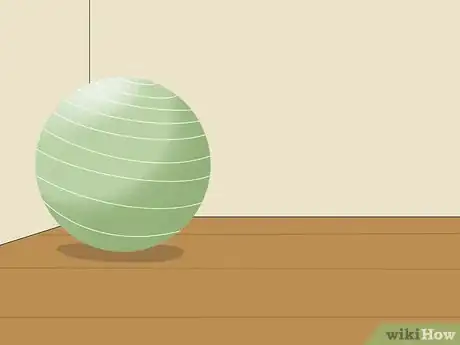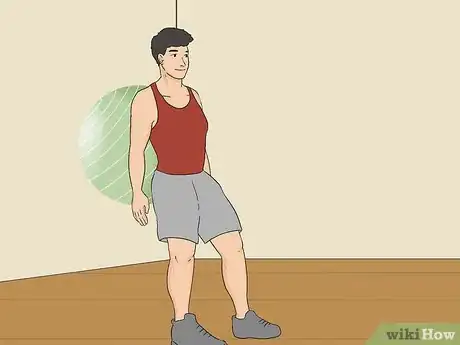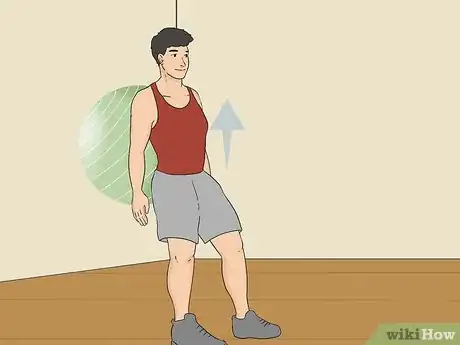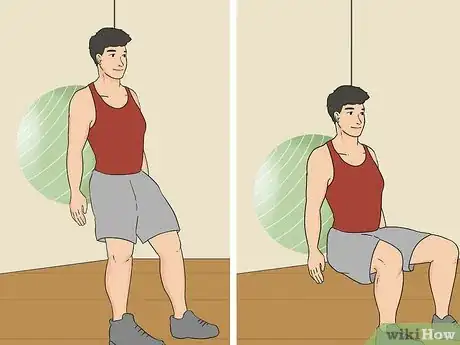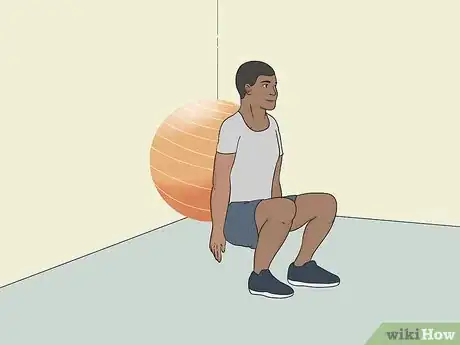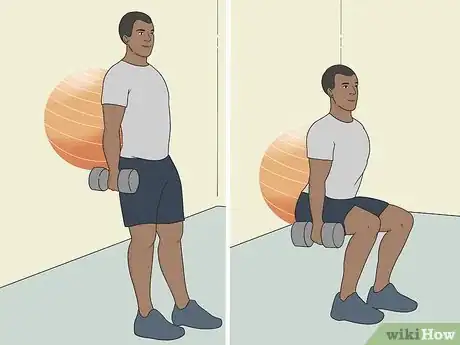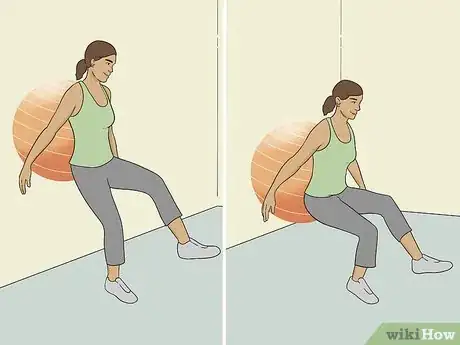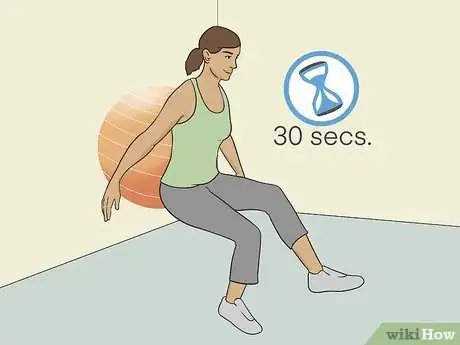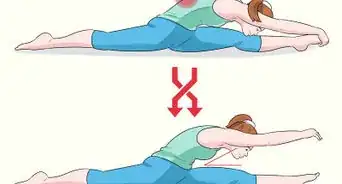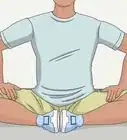This article was co-authored by Adam Shuty. Adam Shuty is a Certified Strength and Conditioning Specialist and owner of ATOMIC Total Fitness, a fitness training studio in New York, New York. With over 15 years of experience, Adam specializes in weightlifting, strength and conditioning, and martial arts. Adam holds a BS in Industrial Engineering from Virginia Polytechnic Institute and State University. In 2014, Adam appeared on the Live With Kelly and Michael Show as one of the top five fitness instructors in the country.
This article has been viewed 39,192 times.
Doing squats with an exercise ball is a great way to work your legs and glutes, and incorporate some stability training at the same time. The basic exercise is suitable for all fitness levels. Once you have mastered the basics, try adding a variation to make the exercise more challenging or to target different muscles.
Steps
Doing the Basic Exercise
-
1Position your exercise ball against a wall. Find a section of wall that does not have any pictures, fixtures, or switches on it. These will get in your way while you do the squats. Place the center of the ball against the wall at the level of your belly button and hold it with 1 hand. It doesn't matter which hand.[1] [2]
- You can buy an exercise ball online or in a sporting goods store if you don’t have one. You can use any size exercise ball for the wall squat since you don’t have to sit on it, but a smaller size works best.
- The ball gives you something to push back against as you squat.[3]
-
2Stand up straight with your lower back firmly against the ball. While holding the ball with 1 hand, turn away from the wall and press your lower back against the ball. Stand up straight with your arms at your sides, your feet shoulder-width apart, and your abdominal muscles tight.[4]
- Look straight ahead as you get into position and while you do the exercise. Do not look up or down as this could strain your neck.
Advertisement -
3Bend your knees to roll the ball down the wall. Once you are in position, slowly bend your knees to lower yourself downwards until your thighs are parallel to the floor. Keep your back pressed against the ball as you do this. Hold the position for 3 seconds.[5]
- Always keep your back vertical as you squat.[6]
Tip: If you feel unsteady leaning against the ball, lower yourself a little at a time and hold the position until you feel more stable. Then, lower yourself a little more or roll back up and repeat the squat at this level.
-
4Push through your heels to roll the ball back to the starting position. After holding the position for 3 seconds, slowly straighten your legs again to stand back up. Center your weight over your heels rather than your toes or the balls of your feet. Keep your back pressed against the ball so that it will roll down your back as you roll upwards.[7]
- Make sure to breathe normally as you do the exercise. It’s best to inhale as you lower yourself and exhale as you stand back up.
- Roll the ball from your hips up to your back.[8]
-
5Do 10 repetitions of this exercise per set. Repeat the process to do another squat and keep repeating it until you have done at least 10 squats. Then, rest for a few minutes, and do another set of 10. Continue to repeat this until you've completed a total of 3 sets.
- Keep in mind that if it’s hard for you to do 10 repetitions, you can start with smaller sets. You will build strength by continuing to do the exercise regularly.
Trying Variations to Add Intensity
-
1Squat down lower to increase your range of motion. If you feel like you can go lower once your thighs are parallel to the ground, go down lower! This will work a wider range of muscles in your legs and make the move feel even more challenging.[9]
- For example, you could squat down an extra 6 in (15 cm) below the parallel point and then come back up.
Tip: You might need to adjust the position of the ball to be able to squat down lower. Start with the ball behind your buttocks instead of your lower back to give yourself a little more leeway to do a low squat.
-
2Hold a dumbbell in each hand to make the squats harder. Grasp a 5 to 10 lb (2.3 to 4.5 kg) dumbbell in each hand before you start squatting. Hold the dumbbells at your sides and then squat as usual. The extra weight will make the move feel instantly more challenging.[10]
- Don’t start with the heaviest pair of weights you can lift! Start with a pair of light weights and move up to a heavier pair if this still feels too easy for you.
- Do 10 repetitions and then repeat the set 2 to 3 times.
-
3Try single-leg wall squats to target the muscles in 1 leg at a time. Another easy way to up the intensity of your wall squats is to stand on 1 foot instead of 2. For example, you could start by standing on your right leg only and do a set of 10 squats, or as many as you are able to do. Then, switch to standing on your left leg and do another set.[11]
- Make sure to do an equal number of repetitions and sets on each leg for a balanced workout.
- Do a set of 10 repetitions on each leg and then repeat the sets 2 to 3 times.
-
4Stay in the squat position for 30 seconds or longer to do a wall-sit. Instead of rolling back up to standing after 3 seconds, you can hold the squat position for 30 seconds or as long as you are able to do a static wall sit with the exercise ball. This will challenge your strength, endurance, and balance![12]
- Increase the amount of time that you hold the position each time you do a wall sit. For example, you might only be able to do 30 seconds the first time you do a wall sit, but then the next time you might make it to 40 seconds.
-
5Change the position of your feet to target different muscle groups. If you want to work slightly different muscles in your legs, you can also try changing the positioning of your feet slightly.[13]
- For example, you could turn your toes so they are facing to your sides to target your inner thighs. Or, you could stand with your feet wider than shoulder-width to target your outer thighs more.
Community Q&A
-
QuestionAre ball squats effective? Are exercise balls a good investment?
 Adam ShutyAdam Shuty is a Certified Strength and Conditioning Specialist and owner of ATOMIC Total Fitness, a fitness training studio in New York, New York. With over 15 years of experience, Adam specializes in weightlifting, strength and conditioning, and martial arts. Adam holds a BS in Industrial Engineering from Virginia Polytechnic Institute and State University. In 2014, Adam appeared on the Live With Kelly and Michael Show as one of the top five fitness instructors in the country.
Adam ShutyAdam Shuty is a Certified Strength and Conditioning Specialist and owner of ATOMIC Total Fitness, a fitness training studio in New York, New York. With over 15 years of experience, Adam specializes in weightlifting, strength and conditioning, and martial arts. Adam holds a BS in Industrial Engineering from Virginia Polytechnic Institute and State University. In 2014, Adam appeared on the Live With Kelly and Michael Show as one of the top five fitness instructors in the country.
Certified Strength & Conditioning Specialist Definitely. There are a lot of fun, unique exercises you can do with an exercise ball as well. If you're looking for an interesting way to do a variety of exercises, this is a great way to go.
Definitely. There are a lot of fun, unique exercises you can do with an exercise ball as well. If you're looking for an interesting way to do a variety of exercises, this is a great way to go. -
QuestionWhy does this hurt my ankles?
 Adam ShutyAdam Shuty is a Certified Strength and Conditioning Specialist and owner of ATOMIC Total Fitness, a fitness training studio in New York, New York. With over 15 years of experience, Adam specializes in weightlifting, strength and conditioning, and martial arts. Adam holds a BS in Industrial Engineering from Virginia Polytechnic Institute and State University. In 2014, Adam appeared on the Live With Kelly and Michael Show as one of the top five fitness instructors in the country.
Adam ShutyAdam Shuty is a Certified Strength and Conditioning Specialist and owner of ATOMIC Total Fitness, a fitness training studio in New York, New York. With over 15 years of experience, Adam specializes in weightlifting, strength and conditioning, and martial arts. Adam holds a BS in Industrial Engineering from Virginia Polytechnic Institute and State University. In 2014, Adam appeared on the Live With Kelly and Michael Show as one of the top five fitness instructors in the country.
Certified Strength & Conditioning Specialist It shouldn't be hurting your ankles, so your form is probably a little off. You really want to make sure that you're guiding your knee gently on your way down so that you don't put too much pressure on your ankle too abruptly. If you have ankle pain even when your form is good, it's an early sign that you're putting too much stress on your ACL, and you might injure yourself.
It shouldn't be hurting your ankles, so your form is probably a little off. You really want to make sure that you're guiding your knee gently on your way down so that you don't put too much pressure on your ankle too abruptly. If you have ankle pain even when your form is good, it's an early sign that you're putting too much stress on your ACL, and you might injure yourself. -
QuestionWhat's the purpose of a Swiss ball squat?
 Community AnswerA Swiss ball squat exercises glutes, quads, and other major leg muscle groups. It also strengthens core muscles.
Community AnswerA Swiss ball squat exercises glutes, quads, and other major leg muscle groups. It also strengthens core muscles.
Warnings
- If you have balance issues, be careful when performing this exercise. You might want to ask someone to spot you or hold onto a chair for added stability.⧼thumbs_response⧽
References
- ↑ https://www.youtube.com/watch?v=rdpFZtaIwKc&feature=youtu.be&t=54
- ↑ Adam Shuty. Certified Strength & Conditioning Specialist. Expert Interview. 25 June 2021.
- ↑ Adam Shuty. Certified Strength & Conditioning Specialist. Expert Interview. 25 June 2021.
- ↑ https://www.oxygenmag.com/training/wall-squat-stability-ball-11645
- ↑ https://www.oxygenmag.com/training/wall-squat-stability-ball-11645
- ↑ Adam Shuty. Certified Strength & Conditioning Specialist. Expert Interview. 25 June 2021.
- ↑ https://www.oxygenmag.com/training/wall-squat-stability-ball-11645
- ↑ Adam Shuty. Certified Strength & Conditioning Specialist. Expert Interview. 25 June 2021.
- ↑ https://www.youtube.com/watch?v=rdpFZtaIwKc&feature=youtu.be&t=54
- ↑ https://journals.lww.com/nsca-scj/Fulltext/2009/02000/Wall_Squat_With_Stability_Ball_and_Dumbbells.9.aspx
- ↑ https://www.shape.com/fitness/workouts/12-ways-spice-your-squats-better-results
- ↑ https://www.shape.com/fitness/workouts/12-ways-spice-your-squats-better-results
- ↑ https://www.shape.com/fitness/workouts/12-ways-spice-your-squats-better-results
